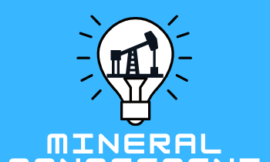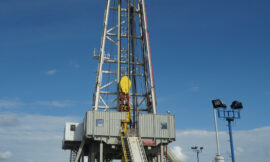The oil and gas industry has seen its fair share of technology advancements over its 162 year year history in the United States. In this episode, we talk about how the oil and gas industry has utilized technology to continue to find ways to produce cheap and reliable energy for the world.
Be sure to also subscribe on Apple Podcasts via the link above and please leave us an honest rating and review. We read every one of them and sincerely appreciate any feedback you have. To ask us a question to be featured on an upcoming episode, please leave a comment below or send an email to feedback@mineralrightspodcast.com.
The First Modern Oil Well
Crude oil has been used for centuries, from the earliest discovery of natural oil seeps but it wasn’t until the first “modern” oil well was drilled in Titusville, Pennsylvania by Edwin Drake in 1859 as we mentioned in MRP 130: What Causes an Oil Price Bust and Will History Repeat Itself?.
After the subsequent oil boom that followed Drake’s discovery, intrepid entrepreneurs found ways to profit from this first energy transition. Instead of hunting whales for whale oil to light towns and cities, early chemists found ways to distill the oil into kerosene and other products to use for lighting and for machine energy.
The Drake Well was notable for a few reasons. Many cite his discovery as the beginning of the modern oil and gas industry. There are many reasons for this. First, Drake invented new techniques for drilling, some of which are still utilized today like the process of driving a conductor pipe into the ground to stabilize the surface hole when drilling. This was a major improvement because in the past when drillers would dig below where the water table existed, water would fill the hole and often cause the hole to collapse.
The Spring Pole “Drilling” Rig
In the era before the Drake discovery, drillers would a spring pole like a bent tree to repeatedly beat a hole into the ground using ropes and chisels. Eventually, cable-tool drilling was invented which introduced the wooden oil derrick which many associate with oil drilling. The power source shifted from horses to steam boilers to power “walking beam” to raise and lower drilling tools.
The Cable Tool “Drilling” Rig
Drilling with a cable-tool rig was slow and tedious as drilling had to be stopped frequently to remove the rock cuttings and to bail out water from the hole. Bits dulled quickly and had to be sharpend and replaced. “Drilling” back then involved the repeated dropping of heavy iron drill strings with different bits to chip away rock. It’s no wonder that they would only be able to drill a few feet per day using this technique.
This is the process that Edwin Drake used on his famous Titusville Pennsylvania oil well. His cable-tool drilling rig featured a six horsepower steam engine and wooden derrick.
The Rotary Drilling Rig
The next advancement in drilling technology was the invention of the rotary drilling rig which is still in use today (Albeit a bit more refined version of the original rotary drilling rig). This “new” technology was utilized to drill the famous Spindletop gusher near Beaumont, Texas. Rotary rigs replaced the repeated pounding away of the cable-tool rig with the concept of a rotating drill bit that featured a hollow drill stem whereby drilling fluids could be pumped downhole to flush out the rock as the drill bit chipped away at the rock. This process is much more efficient and had the side benefit of providing hydrostatic pressure at the bottom of the well which helps to prevent blowouts. A blowout is the dangerous situation where oil and gas under pressure shoots out of the hole and into the air. This is often the image we think of with the early “gushers” that were drilled. This is a bad situation for many reasons, it is wasteful and can cause an explosion or fire if the oil or gas is ignited. In fact, in 1924 the first Blowout Preventer was invented which largely stopped this dangerous uncontrolled situation from happening. A blowout preventer is a large high pressure valve which uses hydraulic pressure to close and seal around the drill string or in a rare emergency, shear the drill pipe and completely seal the hole.
The early rotary drilling rigs were steam powered and did not have directional drilling capabilities. Steam boilers presented a potential safety issue and many drillers died from boiler explosions. In fact, the book Roughnecks, Drillers, and Tool-Pushers by Gerald Lynch provides a first hand account of what it was like to work on a drilling rig in the 1920’s – 1950’s. The author recounts his fear of a boiler explosion and how he would run and hide behind a tree when refilling a boiler after the water level was allowed to get too low because of the fear of an explosion. In fact, he mentioned how a particular rig was a concern and after he left and moved on to work on another rig, the driller that took over was killed by a boiler explosion.
Advancements in Rig Power
Advancements in powering drilling rigs were made in the 1950’s and diesel generators replaced the steam boiler. In fact today, many drilling rigs are powered by natural gas generators or more and more simply by electric power if it is available.
Historically, drilling rigs turned the drill bit through drill pipe which was driven using a motor connected to the Kelly bushing which mated to a specialized piece of drill pipe called the kelly. The kelly bushing was fixed to a rotating table at the drill rig floor. As the bit drilled deeper, new sections of drill pipe were added to the bottom of the kelly section.
Since then, advancements like the use of top-drive motors to turn the drill string. The top drive is a rotary motor assembly is at the top of the drill pipe and travels along the drill rig mast as the well is drilled. The advantage of the top drive is that it allows the application of rotation while pulling out of the hole. This can help prevent the drill bit from getting stuck.
A more recent development is the use of a downhole mud motor to apply torque to the drill bit. In these systems, the drill pipe is not rotated, but instead pumping mud down the drill string turns a pump at the bottom of the drill string above the drill bit which then applies torque directly to the bit.
Directional Control and Horizontal Drilling
These advancements in drilling technology have made it more feasible to apply directional control to where the bit travels. In the past, wells were drilled vertically into the formation which allowed for a limited amount of exposure to the target formation or layer of rock where oil & gas were thought to be found.
Now, there are several more advanced types of directional control like rotary steerable systems which may use a kelly or top-drive to turn the bit but special computerized controls apply force to the drill pipe in a certain direction just above the drill bit to “steer” it where they want it to go.
In fact, it has gotten so advanced that geologists now monitor drilling and can remotely steer the drill bit to ensure that the wellbore stays in the target formation as the drill bit travels horizontally thousands of feet from the surface hole location.
This process of drilling vertically down to the desired depth and then turning the bit until it travels horizontally, sometimes several miles in one direction, is called horizontal drilling. One of the benefits of horizontal drilling is that fewer wells have to be drilled in order to produce oil & gas from the target formation. In the past when vertical wells were drilled, depending on the ideal well spacing, often one well was drilled for every 20 or 40 acres of land. For a typical 640 acre section, with 20 acre spacing, you would end up will 32 separate well pads each with one well and the associated production equipment like a pump jack and tanks to store produced oil and water. This is a significant surface disturbance and if you’ve flown over areas like Bakersfield California or West Texas you can see this patchwork of roads and wellpads dotting the surface.
Pad Drilling and Reducing the Environmental Impact
In the early 2000’s as horizontal pad drilling started to take hold, these same 640 acre section could be drilled from a single wellpad and horizontal wells stretching out under that section meant that more oil and gas could be produced with a much lower environmental impact.
Mitchell Energy pioneered the combination of horizontal drilling with hydraulic fracturing in the Barnett Shale near Fort Worth, Texas. This is the technology that unlocked the shale revolution of the 2000’s. Hydraulic fracturing has gotten a bad name for no good reason. In fact, did you know that it was invented in 1865 by Edward A.L. Roberts with his patent for the use of an explosive device that was lowered downhole to the target depth and the wellbore filled with water to concentrate the explosion to the oil bearing rock. This device was called the “torpedo” and the resulting explosion and fracturing of the formation deep below the ground provided a dramatic increase well productivity.
Hydraulic Fracturing
This is different than the modern day fracture treatment, where they will perforate the casing in a specific pattern at designated intervals along the horizontal section and then use specialized plugs and high pressure pumps to pump down sand (also called “proppant” because it props open the tiny fractures in the rock and allows oil and gas to flow through the cracks), water, and other emulsifying chemicals to keep the proppant entrained in the liquid. In fact, most fracture fluids contain around 99 percent water and sand and around 1 percent other additives. Usually the additive found in the highest concentration is some sort of a gelling agent, like guar gum. In fact, many additives are food grade chemicals. Other chemicals that might be used are corrosion inhibitors, biocides, friction reducers, and acid. The Website Fracfocus.org has more information and in fact you can find out the exact chemicals that were pumped into the wells that you are paid royalties on. Many state oil and gas commission websites link directly to this frac focus database or you can search directly on frac focus for this information.
One common misconception about hydraulic fracturing is that these fractures can threaten aquifers and other drinking water sources and this simply is not true. Operators are required to provide multiple barriers in the form of casing pipe that is cemented through the water bearing zones and special testing procedures to ensure the integrity of this wellbore and cement layer in these critical areas. The reason this is done is because the only way the aquifer could become contaminated is if oil or gas or chemicals were to travel up along the outside of the wellbore (between the pipe and the formation) and into the freshwater zones. This is prevented by multiple pipes that are cemented in place and ensuring that the cement fully fills the space between the pipe and the rock formation that is being protected.
“Completing” an Oil Well
These steps are required by regulation and test confirm that there is good wellbore integrity before the step of completing the well is allowed to proceed. The term “completions” or completing a well refers to the steps that are performed after the well is drilled and the casing is cemented in place. This is usually after the drilling rig is moved off the pad. The completions process today involves setting up portable water tanks, dozens of high pressure pumps on semi trailers, sand, pipes, and valves and other equipment on the wellpad to allow the service company to follow the recipe outlined by the completions engineer. Today, a modern horizontal well has multiple frac stages along the length of the horizontal wellbore that travels through the target formation. The number of frac stages that are used depends on the lateral length of the wellbore but it is not uncommon for there to be dozens of stages or individual fractures that are made at certain intervals.
Once the plugs separating the fracture stages are drilled out or plugs removed and fracking equipment is moved off, the wells are flowed back. This is the initial process of unloading the well and oil, gas is allowed to flow from the well along with the majority of the frac fluid and sand. This is a temporary process that usually lasts from a few days to a few weeks and specialized flowback equipment (affectionately named sand traps) which includes sand separators and other equipment to effectively handle the flowback fluid and higher initial flowrates than the typical production equipment is designed to handle.
Modern Day Oil and Gas Production
Finally, once the flow rates decrease to within the design parameters of the permanent production facilities, the wells are connected to the production facilities and handed over to the operations team to take care of from there.
Many wellpads have production facilities on location, in this case you may see separators, dehydrators, meter buildings, which will look like a series of tanks or vessels on one side of the wellpad. Flowlines are usually buried and run under the ground from the wellhead to the production facilities and from there to the gathering pipeline for water, oil, and/or natural gas. In some cases, operators build central processing facilities so that these steps are taken care of at a central location and gathering pipelines take the mixture of oil, water, and gas from the wellpad to the facility where separation and gas treatment occurs.
Then vs. Now: Conventional vs. Unconventional Wells
Many advancements have been made since the early days of wooden derricks and steam powered drilling rigs to today’s fleet of electric drilling rigs, efficient completion techniques, and modern production equipment.
In conventional oil and gas plays, geologists would evaluate seismic data to try to determine where source rock and geologic traps containing a reservoir of oil or gas might exist. Wells were then drilled vertically in a patchwork fashion to tap these reserves. Back then, the way to produce more oil out of the formation was to apply different procedures to try to stimulate the well or to apply what was called enhanced oil recovery like pumping water or CO2 down injection wells to drive oil and gas towards a production well to drive out more of these valuable fluids.
The combination of hydraulic fracturing with horizontal drilling has revolutionized the industry and made it economical to target formations that were once seen as incapable of production. In fact, these shale layers that are now being targeted in many basins and major plays were once seen as the source rock or cap but not the target reservoir. By drilling horizontally from a single well pad, operators can efficiently and effectively extract the oil and gas below multiple square miles of land.
Securing Our Energy Future
This has a positive impact on the environment as well with a significant reduction in surface impacts, lower emissions that allow operators to produce more oil and gas while having a smaller impact on the environment than ever before. In fact, the strict environmental regulations here in the United States allow us to produce with a lower carbon footprint than many other countries, like Russia. We talk about this in more detail in MRP 119: Carbon Intensity of U.S. Oil Production Compared to OPEC and Russia.
Because the energy needs of today cannot be met by renewable energy alone, these advancements in technology will allow us to reduce our carbon footprint and will make oil and natural gas more sustainable. By ensuring cheap, reliable, and sustainable oil and gas production the United States is positioned to help meet the energy needs of the world today and tomorrow until there is something better. In fact, there are additional benefits to domestic oil and gas production like the economic benefit that results from private mineral ownership in the United States. The economic boost that we see from royalty owners spending these royalties on goods and services is another reason the U.S. should continue to responsibly produce the energy that the world needs.
Resources Mentioned in This Episode
- The Prize: The Epic Quest for Oil, Money & Power By Daniel Yergin
- An Energy Revolution: 35 Years of Fracking in the Barnett Shale
- MRP 130: What Causes an Oil Price Bust and Will History Repeat Itself?
- Drilling Technology – Provides an overview of the advances in Drilling Technology and how this has revolutionized the industry.
- Making Hole – Drilling Technology (American Oil & Gas Historical Society). “Petroleum industry answers to necessity and opportunity for finding oil and natural gas at greater depths.”
Thanks for Listening!
To share your thoughts:
- Leave a comment or question below (we read each one and your question may be featured in a future episode)!
- Ask a question or leave us feedback via email or voicemail: (720) 580-2088.
To help out the show:
Click the Apple Podcasts Logo Above to leave us a rating & review. It really helps us reach those that need to hear this information and only takes a minute. We greatly appreciate it! Plus, you can get a shout out on a future episode!
Thanks again – until next time!





Pingback: MRP 132: The Economic Impact of the Oil and Gas Industry – The Mineral Rights Podcast